Can You Burn Pellets In A Wood Stove?
- October 3, 2023
- 11 comment
While wood stoves are traditionally designed to burn cordwood, many homeowners find themselves wondering if they can also burn pellets in these stoves. Pellets, after all, are compact, easy to handle, and often more environmentally friendly due to their consistent burn and lower emissions. To answer the question directly: Yes, you can burn pellets in a wood stove, but there are considerations to keep in mind. Let’s delve deeper into this topic.
What Are Pellets?
Pellets, often touted as a modern solution to traditional heating challenges, are more than just tiny pieces of compressed wood. Their origins, design, and inherent properties make them a unique fuel source. Let’s unravel the story of pellets.
Why Use Wood Pellets in a Wood Stove?

The use of wood pellets in traditional wood stoves has been gaining traction due to their numerous advantages over conventional firewood. One of the primary benefits lies in their environmental friendliness. Made from compressed sawdust and wood waste, wood pellets provide a cleaner burn, resulting in fewer emissions. This not only helps reduce our carbon footprint but also ensures a more eco-friendly heating option. Moreover, when we talk about pellet burning efficiency, wood pellets stand out. Their uniform size and consistent moisture content allow for a more efficient burn, delivering more heat while consuming less fuel.
This efficiency translates to potential cost savings over time. Another noteworthy advantage is their consistency in burn rate and heat output, ensuring a steady temperature in your home. Storage and maintenance also become more manageable with wood pellets. They occupy less space due to their compact nature, and the reduced creosote buildup and ash production mean a safer and cleaner stove experience. While wood pellets offer a sustainable and efficient heating alternative, always consult with professionals before making a transition to ensure your stove’s safety and performance.
Origins of Pellets
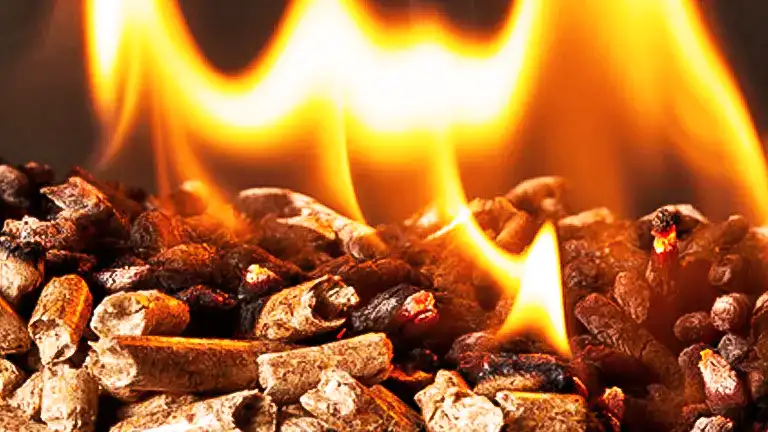
The history of wood pellets traces back to the 1970s, during the oil crisis when there was a strong demand for alternative heating sources. Industry innovators saw an opportunity in the vast amounts of wood waste—like sawdust and shavings—generated by lumber mills. By compressing this waste, they found they could create a new type of fuel: the wood pellet.
Manufacturing Process

Creating a pellet isn’t as simple as just pressing wood waste together. The process involves:
- Collection of Raw Materials: This doesn’t just mean sawdust. Pellets can be made from various wood waste products, including bark, wood chips, and even agricultural residues like straw.
- Drying: To ensure efficient combustion, the moisture content of the raw materials needs to be reduced, typically to around 10-20%.
- Compression: High-pressure machinery compresses the dried raw materials. The natural lignin within the wood acts as a glue, binding the material together into the pellet shape.
- Cooling and Hardening: Once formed, pellets are cooled to harden and stabilize their shape.
- Quality Control: Pellets undergo checks for density, moisture content, and combustion value. Only those meeting specific criteria make the cut.
Characteristics of Pellets

- Size and Shape: They are usually small cylinders, less than an inch long and about a quarter of an inch in diameter.
- Consistent Properties: Unlike cordwood, which can vary significantly in moisture content and energy value, pellets have uniform properties. This consistency is a product of the controlled manufacturing process.
- High Energy Value: Due to their low moisture content and dense composition, wood pellets typically have a higher energy value per pound than green wood.
- Eco-Friendly: Because they’re made from waste products, wood pellets are considered a renewable energy source. When combusted, they release the carbon dioxide that trees absorb during their growth, making their carbon footprint neutral.
Advantages Over Cordwood
The main benefit of wood pellets over cordwood is consistency. Cordwood’s varying sizes, species, and moisture contents can lead to unpredictable burning behavior. In contrast, the standardization of pellets offers more consistent combustion, producing a steady heat output and reducing the emissions of harmful particulates.
Pros of Burning Pellets in a Wood Stove

As energy needs evolve and environmental consciousness grows, the push towards more sustainable and efficient fuel sources is undeniable. Among these, wood pellets stand out, especially when used in traditional wood stoves. Let’s delve into the specific advantages of using pellets in such settings.
Superior Efficiency
- Optimal Moisture Levels: One of the keys to efficient burning is low moisture content. Wood that’s too damp can smolder, produce excessive smoke, and result in incomplete combustion. Pellets, however, have been engineered to possess a moisture content that’s optimal for burning, usually around 5-10%. This ensures they ignite easily and burn hot.
- Reduced Creosote Formation: Creosote, a byproduct of wood combustion, can accumulate in chimneys and pose a fire risk. Thanks to the consistent and complete combustion of pellets, they produce significantly less creosote than cordwood. This not only reduces the risk of chimney fires but also means fewer maintenance calls and cleaner chimney sweeps.
The Convenience Factor
- Space-saving Storage: Unlike bulky logs that can take up significant space, pellets come in compact bags. These can be stacked efficiently in a garage, shed, or storage room, making them ideal for homes with limited storage space.
- Ease of Handling: No more labor-intensive chopping, stacking, or seasoning. Pellets eliminate these traditional wood preparation steps. Simply purchase, pour, and ignite. This streamlined process can save homeowners time and effort, particularly during colder months when heating demands are higher.
- Predictable Performance: The uniform size and composition of pellets mean that they burn predictably. There’s no guessing game as with cordwood, where different sizes or wood types might burn at varying rates or produce inconsistent heat.
Championing the Environment
- A Circular Economy: Pellets are typically made from the byproducts of the lumber industry, like sawdust and wood shavings. Instead of these materials going to waste, they’re repurposed into a valuable fuel source. This efficient use of resources promotes a circular economy where waste is minimized.
- Reduced Carbon Footprint: Trees naturally absorb carbon dioxide (CO2) during their growth. When pellets made from wood are burned, they release the CO2 that was previously absorbed. This creates a carbon-neutral cycle. In contrast, burning fossil fuels releases previously stored carbon, adding to the overall CO2 levels in the atmosphere.
- Cleaner Burn: Thanks to their consistent makeup and low moisture content, pellets tend to produce fewer emissions than cordwood. This translates to less particulate matter released into the atmosphere, contributing to better air quality.
Cons and Considerations

While pellets offer an array of benefits, they come with their own set of challenges, especially when introduced to a setting they aren’t specifically designed for traditional wood stoves. Understanding these drawbacks can guide users to make informed decisions and take necessary precautions.
The Hurdle of Inconsistency
- Design Mismatch: Traditional wood stoves are crafted for burning logs, which have varying sizes and moisture contents. Their design elements, from grates to airflow mechanisms, are attuned to this variability. Pellets, with their uniform nature, sometimes don’t align with these design features, leading to unpredictable burns.
- Hotspots and Cold Patches: Due to the inconsistent burn, certain areas of the stove might become hotter than others, leading to a less uniform heating experience. This can mean fluctuating room temperatures and less overall comfort.
Airflow
- Starved Combustion: For optimal combustion, any fuel source needs the right amount of oxygen. Pellets, due to their density and compact nature, require consistent airflow to maintain efficient burning. Without this, they might smolder rather than burn, leading to energy wastage and potential smoke.
- Safety Implications: Insufficient airflow can also result in the incomplete combustion of pellets, which might lead to the production of carbon monoxide, a dangerous and odorless gas. Ensuring good ventilation and having a functioning carbon monoxide detector is vital when using pellets in a traditional wood stove.
Dealing with Pellet Residue
- Melting and Solidifying: When burned, some pellets can release binders or other residues that melt and then solidify as they cool. Over time, this can create hard clumps at the base of the stove, impacting the stove’s efficiency and necessitating more frequent cleanups.
- Ash Production: While pellets generally produce less ash than cordwood, the ash they do produce is finer and can clog the stove’s air vents or ash pan faster than coarser wood ash.
Wear and Tear
- Stress on Stove Components: Using pellets in a stove not specifically designed for them can stress certain components, especially if the stove heats unevenly or hotter than usual. Over time, this might lead to premature wear or even damage to parts like the grate, liners, or baffle.
- Potential for Voided Warranties: Some manufacturers might void the warranty on a wood stove if it’s used to burn materials it wasn’t designed for, such as pellets.
Safety First

Burning any fuel comes with its own set of risks, and when one ventures into non-traditional territory—like using pellets in a wood stove—the importance of safety cannot be overstated. To ensure that your pellet-burning experience is both efficient and safe, here are some foundational safety measures to adhere to:
Breathe Easily with Proper Ventilation
- Avoiding Harmful Buildups: Insufficient ventilation can lead to a buildup of harmful gases like carbon monoxide—a colorless, odorless gas that can be lethal in high concentrations. Always make sure there’s adequate airflow for the complete combustion of pellets.
- Regular Maintenance: It’s advisable to have your chimney and ventilation system inspected and cleaned at least once a year. If you’re burning pellets frequently, consider increasing the frequency of these inspections. Clean chimneys and vents not only ensure proper ventilation but also reduce the risk of chimney fires caused by creosote buildup.
Keep a Watchful Eye
- Detecting Inconsistencies: Pellets in a traditional wood stove can sometimes burn unevenly. Regularly inspecting the burn can help you detect any inconsistencies, such as pellets that aren’t igniting or areas that are smoldering too much.
- Reacting Timely: By keeping an eye on the burn, you can adjust the amount of pellets, their position, or the airflow to achieve a more consistent and efficient combustion.
Maintaining Cleanliness
- Regular Cleaning: As you burn pellets, they’ll produce ash and other residues. Regularly removing these ensures that the stove operates efficiently and safely.
- Managing Residues: Pellets, especially low-quality ones, might produce more ash or even clinkers—hard, fused residues. Cleaning these out prevents them from obstructing airflow or impacting the stove’s performance.
- Inspecting Stove Parts: When you clean, it’s also an opportune time to inspect the stove’s parts for any signs of wear or damage. Checking the condition of grates, liners, and seals can help you detect potential problems before they escalate.
Can I Use Pellets in a Fireplace Insert?
Using wood pellets in a fireplace insert is both practical and advantageous. Begin by ensuring you have a suitable pellet tray or basket for holding the pellets. Once set up, the fireplace insert should operate at its maximum airflow settings for the best combustion results. Position the pellet tray or basket centrally, fill it following the recommended guidelines, and light it with traditional kindling methods. A notable feature of pellets is their efficiency; they tend to burn cleaner and last longer than many conventional fuels.

The benefits of wood pellets span several dimensions. They represent a cost-effective method of heating, potentially leading to savings on heating bills. Environmentally speaking, they offer a green alternative, aiding users in reducing their carbon footprint. Moreover, the clean-burning characteristics of wood pellets mean they produce minimal ash, especially when compared to traditional cordwood. Additionally, the compactness of wood pellets introduces practical advantages, especially in terms of storage and potential cost benefits.
Pellet Stoves: An Alternative
For those keen on burning pellets, it’s worth considering purchasing a pellet stove. These stoves are specifically designed to burn wood pellets efficiently, providing a consistent heat source and reducing the concerns associated with burning pellets in a traditional wood stove.
For a more in-depth exploration, take a look at this article. Wood Stove vs. Pellet Stove 2023
Conclusion
While it’s technically possible to burn pellets in a wood stove, it comes with challenges and potential risks. Always prioritize safety and consider the specifications of your particular stove. For those committed to the idea of using pellets as a primary heat source, investing in a pellet stove might be the best way forward.
As winter nears, pellet stoves are an efficient, eco-friendly heating solution. Finding pellets for stoves can be challenging, but local stores and online platforms offer various options. So, if you’re searching for pellets for stove near me, a quick online search or a trip to a local store should suffice. It’s advisable to stock up on pellets before winter.
Looking for the perfect wood stove for your home? Dive into our other articles for some top picks and insights!
- 10 Best Wood Stoves for Your Home in 2023
- Best Camping Wood Stoves 2023
- Best Small Wood Stoves on Amazon 2023
FAQs
- I’ve heard about “pellet baskets” for wood stoves. What are they?
Pellet baskets are specially designed metal containers that fit inside traditional wood stoves. They allow you to burn pellets without a dedicated pellet stove. Simply fill the basket with pellets, light it up, and enjoy the warmth! - Can I mix pellets and cordwood together in my wood stove?
While technically possible, it’s not always recommended. Mixing the two can affect combustion efficiency, potentially causing incomplete burns or producing more creosote. If you want to try, always monitor the burn and consult your stove’s manufacturer guidelines. - Do pellets produce a different aroma compared to traditional logs when burned?
Yes, they can. Since pellets are compressed wood waste, the scent they produce might be less “woody” than traditional logs. Some people find it less noticeable, while others feel it has a cleaner or more neutral scent. - If I consistently burn pellets in my wood stove, will it affect its lifespan?
Burning pellets in a stove not specifically designed for them can cause uneven heating or wear on certain components faster. Regular maintenance and monitoring can mitigate these effects, but over time, the lifespan of the stove might be marginally affected. - How do wood stove pellets differ from those used in pellet grills for cooking?
While both are made from compressed wood, cooking pellets often use specific wood types to impart flavors to the food (like apple, hickory, or mesquite). Heating pellets prioritize energy content and consistency over flavor. It’s crucial not to use heating pellets for cooking due to potential additives or treatments. - Are there different grades or qualities of pellets to consider?
Absolutely! Premium-grade pellets typically have lower ash content and are made from hardwood or a blend of wood types. Standard or low-grade pellets might have more additives and produce more ash. Always check the label and choose based on your stove’s recommendations and personal preference. - I’ve seen “softwood” pellets. Aren’t hardwoods better for burning?
Contrary to popular belief, softwood pellets often have higher BTUs (energy content) and can burn hotter than hardwoods. They do, however, sometimes produce more creosote, so regular chimney cleaning is essential. - Can I make my own pellets at home for my wood stove?
While pellet production is possible with specialized equipment, making them at home isn’t common due to the complexity of achieving consistent compression, size, and moisture content. Commercially-produced pellets undergo stringent quality control to ensure safety and efficiency.
And there we have it! We’ve journeyed through the ins and outs of burning pellets in wood stoves. But hey, this isn’t just about what we think—what about you? Have you given pellets a try in your wood stove or thought about it? Whether you’re a pro, a newbie, or somewhere in between, we’d love to hear from you. Drop your thoughts, experiences, or even your burning questions in the comments. Let’s keep this chat warm and lively. After all, the best tips and stories come from awesome readers like you!

David Murray
Forestry AuthorI'm David Murry, a forestry equipment specialist with a focus on chainsaw operation. With over 13 years of experience, I've honed my skills in operating and maintaining a wide range of machinery, from chainsaws to log splitters. My passion for the outdoors and commitment to sustainable forestry drive my work, which emphasizes safety, efficiency, and staying updated with industry advancements. Additionally, I'm dedicated to sharing my expertise and promoting environmental awareness within the forestry community.
11 comments
Will the technology evolution reach the point where you can cook or make hot coffee on a pellet stove?
Mary Boehme
October 5, 2023 11:07 amAm I missing something? If I burn trees it releases stored CO2, making it carbon neutral, but , if I burn fossil fuels (which aren't from fossils) it releases stored CO2 which increases the carbon footprint.????
Shepard
October 5, 2023 2:17 amBeen cutting and splitting wood for 50 years. Never chopped wood in my life. Not sure what that means
Ernie Ferguson
October 5, 2023 1:41 amCould use pellets in your stove, but it would be a waste of money because they’re designed for a pellet grill which burns them slowly you would have to dump in bucket loads and a big fire, and it would instantly burn them up within a few minutes time, so yeah if you’re willing to take a $20 bag That would blast you probably a few weeks with a pellet grill and Myrna hole $20 bag within 20 minutes time go ahead it’s your money
Paul
October 4, 2023 3:35 pmYou do know that they’re talking about HEATING pellets, right? NOT grilling or smoking pellets. Heating pellets range from $4-$10 per 40lb bag. I heat half my home with pellet stoves. But these are actually specifically designed for pellets and cannot burn whole wood.
Buddy C
October 5, 2023 1:46 amPrice per pallet delivered Bantry area Co. Cork.
Liam P Cunningham
October 4, 2023 11:03 amIf you're looking for the convenience of pellets but only have a wood stove, there is a product called biobricks that are basically large pellets designed to be burned in a wood burning stove. They are very close in price to average price of pellets per ton.
Paul Grayson
October 4, 2023 5:03 amHello, I live in Ireland and I have a Stanley multi fuel burning stove with a fitted water boiler which heats the rooms of the house and supplies hot water for personal use, looking at stoves in USA and Canada this seems not to be the case. Is operating a stove a bit of waste if no boiler is absent from the stove?
Joseph Murphy
October 3, 2023 8:05 pmI am a Canadian living in Ireland. Unlike house heated with hot water rads in Europe, many houses in NA use forced air furnaces heated by gas, oil or electricity. Back boilers and the such are not common at all. Wood stoves are used as supplementary heat to keep cost down or if you live in areas with an abundance of trees it can be your primary heat source. Houses in NA are usually much better insulated than Ireland and wood stoves are ideal for heating.
MDC
October 5, 2023 3:17 pmI have been using pellet conversion burners for years. My first was a 60,000 btu unit installed into a steel box cord wood boiler rated for 100,000 btu. My second is a 650,000 btu pellet burner installed into a 1,000,000 btu cast iron 12 section boiler. I am now converting two 350,000 btu hot air recycled oil furnaces. All my pellet conversion come from Europe from a company named Pelltec. Ken


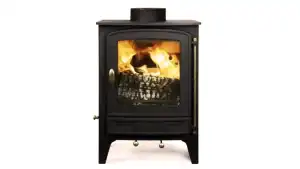


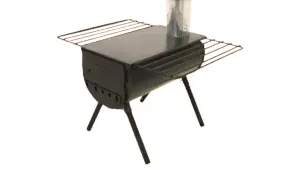
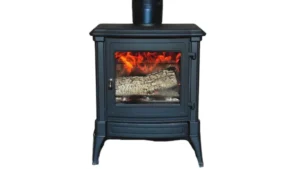


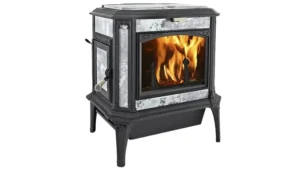

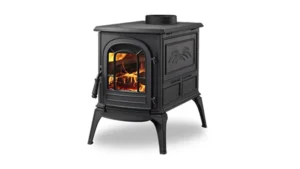
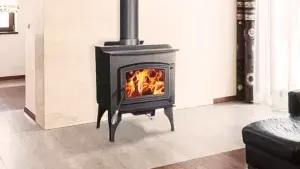
I had thought about using pellets in my logburner and was looking for a suitable, reasonably priced container. Then it occurred to me that adding pellets to the stove once they had burned down was going to be difficult if not dangerous. How do you get the very hot pellet basket out to refill it? Putting fresh pellets into a hot basket runs the risk of ignition before you have put it back!
Paul Bradford
October 6, 2023 1:27 pm